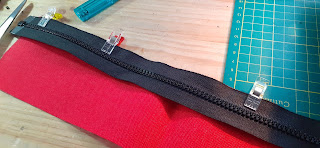With the plague dying down* I have continued to look at IFAKs and general first aid equipment, throwing different techniques and general silliness at the question. With my last post, I explored a field carry pouch which mounted to my regular equipment. This time around I wanted something more every day carry that you could stick in the bottom of a bag or the glove box of your car.
I went with a roll out design, the idea being that you access the trauma shears and gloves on the outside to force you take a moment to chill before diving in and then opening it up to do the thing.
Trauma shears on the reverse aren't entirely necessary for every day carry but with a pair of Raptors, there's enough useful stuff on there that carrying them is handy.
I remembered a flap for the glove pouch this time! Soiled gloves are no use to anyone so having something to minimise ingress of dirt and debris is helpful. I might go one step further in the next iteration and use some elastic slots to tuck in some Kinder Egg toy shells and pop a pair of gloves in each of those for maximum cleanliness.
Roll it out for the business end - same high contrast interior as last time. The interior here was mostly to test out different techniques and see what worked from a construction point of view. I need to find a better way of storing scissors because the elastic loop there isn't going to do the job. The elastic loops for the bandages point to an interesting direction I could take for larger first aid pouches.
The major draw back with this design is the orientation. I think if I had rotated the inner pouches by 90 degrees then I could have had more space for more stuff but also it's less likely to spill everywhere when opening. I don't like flaps inside my pouches but I probably should have elasticated the interior so as to better secure the contents.
For every day use, this will work fine. There's still lots of space within the internal pockets for extra stuff. I was surprised that the supposedly HSE compliant refil kit that I used for this one didn't come with gloves. They're pretty essential so be sure to check your kit has them when sourcing your own equipment.
Elsewhere, we have games from 10th April here in the UK so I'm going to have to do a kit review before those kick off. The Cali and the Gryphon both need stripping and servicing before I take the field again. I'm not sure what state my general webbing is in so I'm sure there will be a blog review post of that when I get around to it.
*By dying down we're past the peak of cases here in London and our critical care admissions are not at the ridiculous pace they were at in January. We're not out of the woods but there is light on the horizon.





